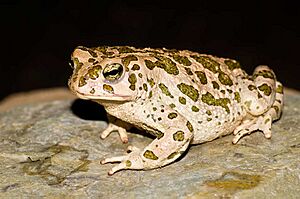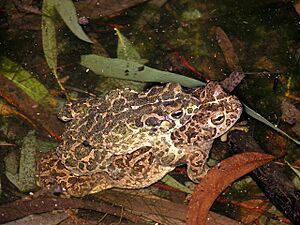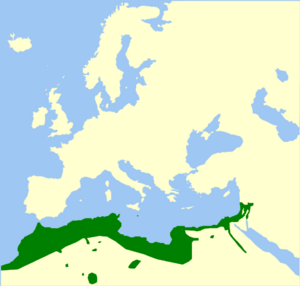African green toad facts for kids
Quick facts for kids African green toad |
|
|---|---|
 |
|
 |
|
| B. b. boulengeri above, B. b. siculus below |
|
| Conservation status | |
| Scientific classification | |
 |
|
| Range of African green toad, but lacking the populations on Italian islands, and incorrectly including Sinai and the Levant | |
| Synonyms | |
|
The African green toad (Bufotes boulengeri) is a type of toad. You can find it in North Africa. Its home stretches from Morocco to Egypt. It also lives on some Italian islands. These islands include Sicily, Favignana, Lampedusa, and Ustica.
For a while, the toads on the Italian islands were thought to be a separate species. They were called the Sicilian green toad. But now, scientists believe they are a very close relative. They are considered a subspecies of the African green toad.
These toads look a lot like the European green toad. They were once even grouped together.
Contents
Where Does the African Green Toad Live?
This toad is very adaptable. It lives in many different places. You can find it from coastal areas to high plateaus. It lives in forests, scrubland, and grasslands. It also lives in semi-deserts and deserts.
Breeding Habits
African green toads need water to lay their eggs. They breed in temporary ponds. They also use similar wet places.
What Does the African Green Toad Look Like?
The African green toad looks similar to other toads in its group. This group is called Bufotes. It looks like the European green toad. It also resembles the Balearic green toad.
Comparing Toads
The African green toad and the Balearic green toad live close to each other. Their ranges meet in eastern Sicily. You can tell them apart by a few things. The Balearic green toad has colored spots on its paratoid glands. It also has some reddish-orange markings. The African green toad does not have these.
The two types of African green toad look very much alike. These are the North African B. b. boulengeri and the Sicilian B. b. siculus. The North African toad might have a stripe down its back. This stripe can help tell them apart.


